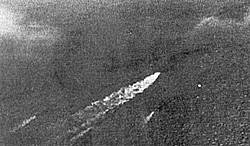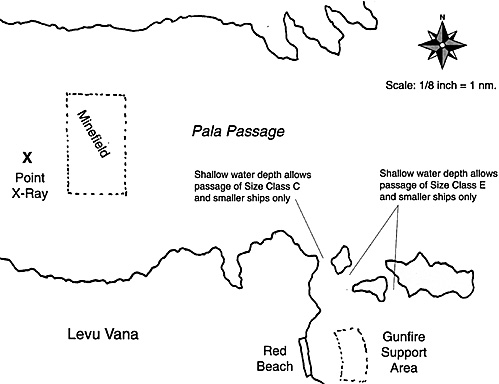Almost every naval buff has watched Otto Preminger's In Harm's Way. It's loaded with big stars, with John Wayne playing the hero, Admiral "Rock" Torrey. It's a soap opera, but it's a good soap opera. The movie has several great action scenes, including the attack on Pear Harbor, Torrey's cruiser being torpedoed, and the climax of the film, the Battle of Pala Passage. Mike Harris found the book, by James Bassett (World Publishing, 1962), that the movie was based on. It includes additional details of the battle, and Mike also pulled information off the video (remember the status board that's shown for a few seconds?). He's assembled it and we played the scenario at Cold Wars '98 in March. See page six for the writeup of a great game.
 Location: 0530 local time.
Location: 0530 local time.
At right, part of the Japanese Task force, including Yamato.
Environment: Gentle wind, 5 knots from 015°. Sea state 2. There is a half moon with wisping clouds as dawn breaks at 0530. Visibility is 25%, clearing to 40% at 0545, increasing to 50% by 0600, to 60% by 0615, and finally to 85% by 0700.
Notice to Mariners: There is a clear deep-draft channel (passable to Size Class A & B ships) in the center 10 nm of the channel. There is a cluster of islands near Red Beach that form several channels. Only the channel closest to Levu Vana is passable, and that only to ships of Size Class C and smaller. The other channels are passable only to Size Class E ships and smaller.
US Operational Situation: The US has been pursuing its "island hopping" strategy in the South Pacific. Recently a new offensive was launched to seize an island called Levu Vana, which has a perfect plateau for a long-range bomber airfield. Operation Skyhook started with seizing the nearby island of Gavabutu as a staging area. From there the current amphibious assault on Levu Vana was launched.
US Tactical Situation: The landing is underway on Levu Vana. The Japanese are putting up a stiff defense, but first reports look good. However, long range reconnaissance has just reported that a powerful Japanese task force is headed this way. Their mission is to destroy the vital logistic ships supplying the landing. Reported at the center of this task force is the massive Japanese battleship, Yamato. Due to operational commitments elsewhere, CINCPAC cannot provide any additional units prior to the projected arrival of the Japanese. Task Force 40 will have to rise to the occasion and protect the landing. Some air assistance will be available from the few PBJ-1s located on Gavabutu.
US Forces: Task Force 40
- Louisville (Northampton-class cruiser)
Indianapolis (Portland-class cruiser)
Nashville (Brooklyn (First Group) class-light cruiser)
DESRON 8
- Rowan, Stack, Sterett, Wilson (Benham-class destroyers)
DESRON 22
- Grayson, Gwin, Meredith, Monssen (Benson-Livermore-class destroyers)
Drum, Silversides (Gato-class submarines)
PT Squadron 5
- PT 104, PT 112, PT 114, PT 115, PT 123, PT 162, PT 165, PT 171 (80 ft Elco-class motor torpedo boat)
Gamble (Wickes-class minelayer with 25 Mk6 mines)
Amphibious Group
- 6 LCI (Landing Craft Infantry)
APA-44 Fremont (Bayfield-class Attack Transport)
APA-45 Henrico (Bayfield-class Attack Transport)
AKA-56 Arneb (Andromeda-class Cargo ship)
AKA-57 Capricornus (Andromeda-class Cargo ship)
Air Assets
- 6 PBJ-1C/D Mitchell medium bombers
US Orders:
Protect the amphibious landing at all costs. Levu Vana must be captured or the Japanese will complete their airfield.
US Victory Conditions:
Decisive: No amphibious units are sunk or forced to withdraw and Yamato is sunk or crippled (greater than 50% damaged).
Tactical: No amphibious units are sunk or forced to withdraw.
US Setup:
Formation is at player's discretion. The Task Force has been covering the amphibious landing and is located off Red Beach. The minefield has already been placed by the Gamble during the night, and is marked on the scenario map. The PTs and the submarines may be placed anywhere east of the minefield. The rest of TF 40 is in the Gunfire Support Area marked on the map.
The PBJs will arrive anytime after 0545 from the southeast. They can appear from 090° to 180° at any altitude desired by the player. The PBJs have a time on station of 15 minutes over Pala Passage. Arrival time must be decided prior to start of the scenario.
Japanese Operational Situation:
The Americans are getting more aggressive after their victory at Midway and are attempting to extend their control in the South Pacific. They have been making greater use of land-based bombers to attack both naval and army units. In a policy of "island hopping," they have made serious inroads into areas thought secure. They have recently captured an island called Gavabutu and from there have launched an amphibious assault against the Imperial forces at Levu Vana. With a large flat plateau, Levu Vana can support four-engine bombers. If they succeed in building an airfield on Levu Vana, our position throughout the region becomes untenable.
Japanese Tactical Situation:
A powerful task force built around Yamato has been assigned to destroy the American landing at Levu Vana. An amphibious force of Imperial Marines is being assembled to follow up the American defeat.
Japanese Forces: Sho Force
1st Battleship Squadron
- Yamato (Yamato-class battleship)
7th Cruiser Squadron
- Mogami, Kumano, Suzuya (Mogami-class cruisers)
3rd Destroyer Flotilla
- Sendai (Sendai-class light cruiser)
11th Destroyer Division
- Amagiri, Asagiri, Yugiri, Fubuki (Fubuki-class destroyers)
6th Destroyer Division
- Akatsuki, Hibiki, Ikazuchi, Inazuma (Akatsuki-class destroyers)
Japanese Orders:
Destroy the American landing forces on the eastern beach of Levu Vana. Do not lose Yamato, or allow her to be seriously damaged.
Japanese Victory Conditions:
Decisive: Sink or force all American landing forces to withdraw, sink or cripple (greater than 50% damage) at least two American major units, and Yamato is not sunk or crippled.
Tactical: Sink or force to withdraw all American landing forces and Yamato is not sunk or crippled.
Japanese Setup:
Formation is at player discretion. The lead unit of the formation may not be east of Point X-Ray.
Special Rules:
Forced to Withdraw. Any unit of the amphibious group that sustains more than 25% damage will withdraw to the south. The LCIs are already underway and capable of immediate withdrawal. The APAs and AKAs are at short stay on their anchors and will take 1 3-minute Tactical Turn to weigh anchor prior to getting underway.

Pala Passage After-Action Report (ns15)
Minefields in Pala Passage
Ships for Pala Passage
Pala Passage After-Action Report (ns21)
BT
Back to The Naval SITREP No. 15 Table of Contents
Back to The Naval SITREP List of Issues
Back to Master Magazine List
© Copyright 1999 by Larry Bond and Clash of Arms.
This article appears in MagWeb (Magazine Web) on the Internet World Wide Web.
Other military history articles and gaming articles are available at http://www.magweb.com